
Hotels in Tianshui
Enter your dates for the latest hotel rates and availability.
Scroll down to see hotels
Filter by:
Hotel Star Rating
≤2345
Guest Rating
Amazing 9+Great 8+Good 7+Pleasant 6+Popular Filters for Tianshui
Tianshui Ancient CityTianshuinan Railway StationBreakfast includedGreat 9+2 bedsFree cancellationQinzhou DistrictNon-smoking roomsWithin 1 kmWithin 2 yearsProperty Type
HotelServiced apartmentGuest houseApartmentFarm stayUnique StaysChinese innVillaHomestayHostelInnProperty facilities & services
Parking availableSpaCurrency exchangePoolLaundry roomFree parkingPets welcomeGymSaunaWi-Fi in public areasLuggage storageWake-up callElevatorRestaurantSmoking areaConference roomEV charging stationCar rentalsairport transfersBarbecueFree airport transfersBarGolf courseWater parkWe found 131 hotels for you in Tianshui
Trip.com offers top-picked hotels in Tianshui, including reviews, price estimates, and facility details to help you choose the best option for you.
Most Booked
Lowest price
Closest to downtown
Highest Rated







99+
Hotel near Tianshui Railway Station,Tianshui
 No. 6 of 4-Star Select Hotels in Tianshui
No. 6 of 4-Star Select Hotels in TianshuiGym
Public parking
Luggage storage
+8
"The service and breakfast were both good. I even forgot something, and the hotel called to thank me for it. However, the strange thing about this hotel is that the air conditioning only turns on at 6 PM. I came back from Maiji Mountain in the afternoon and was really cold, wanting to rest in the room. But I ended up having to wear my down jacket indoors. Air conditioning only starting at 6 PM? This is the first time I've encountered something like this in all my years of traveling!"
Very Good
1180 reviews
9.3/10
1 night
From PHP 1,410
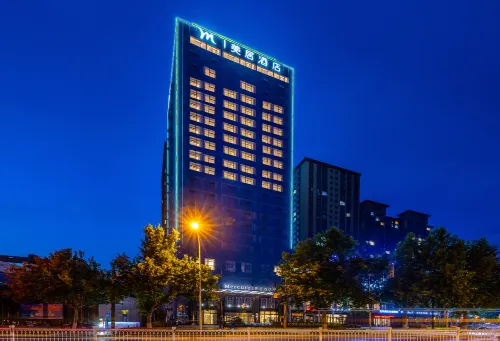






99+
Hotel near Wanda Plaza(Qinzhou),Tianshui
 No. 3 of 4-Star Select Hotels in Tianshui
No. 3 of 4-Star Select Hotels in TianshuiGym
Public parking
Luggage storage
+9
"This was the second Mercure hotel on our trip, and overall, the facilities were quite good.
**Facilities:** The hotel is well-equipped. The lobby is clean and bright. As expected from an Accor property, the decor style and design elements are largely consistent. What truly stood out was that on each floor's common area, right outside the elevator, there was a row of complimentary bottled water. This is quite rare in other hotels and very convenient for guests to grab. Breakfast is served on the 21st floor, offering a panoramic view and a great sense of openness. On another note, staying on the 14th floor, the water pressure was a bit low, and the shower felt like it didn't have enough flow.
**Hygiene:** The room's cleanliness was generally acceptable, but I found a long hair stuck to a tile in the bathroom. It felt like the cleaning wasn't thorough, which was a bit off-putting. Also, there was a small tear on the bed linen. I'm not sure if it was an oversight, but ideally, it should have been replaced.
**Service:** The hotel's front desk manager took my feedback very seriously. Afterwards, they even proactively called us to inform us that the issues had been rectified. This was truly excellent."
Excellent
2754 reviews
9.7/10
1 night
From PHP 2,634
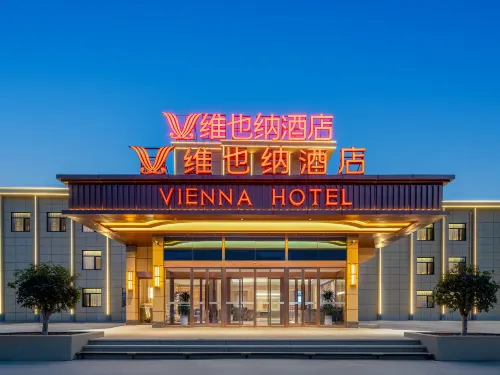






98
Hotel near Tianshui Railway Station,Tianshui
Gym
Public parking
EV charging station
+7
"超級好評!!!!這次入住維也納酒店真的太驚喜了!從進門開始就感覺特別舒服,房間收拾得一塵不染,床單被罩乾淨得像新的一樣,連角落都沒什麼灰塵,住起來特別安心。
更讓我感動的是工作人員的服務,態度特別親切,全程都是笑眯眯的,讓人心裏暖暖的。最讓我印象深刻的是,帶孩子入住後,我想着給孩子接觸的地方消消毒,隨口跟前台提了一句需要酒精,本來沒抱太大期望,結果工作人員二話不説,專門出去買了酒精回來,還細心地幫我們把桌椅、床頭這些孩子容易碰到的地方都噴了一遍,特別周到。
這種能照顧到顧客特殊需求的服務,真的太加分了!房間整潔舒適,服務又這麼貼心,下次肯定還來住維也納酒店,必須好評!"
Excellent
349 reviews
9.6/10
1 night
From PHP 1,511







99+
Hotel near Tianshui Railway Station,Tianshui
Gym
Private parking
EV charging station
+8
"Come to Maiji District, Tianshui again. The hotel I found on Ctrip is very cost-effective. It is next to the old train station, but not noisy. The front desk service is very good, and the room was upgraded directly. The staff said that it was completely renovated in 2023, the glass is double-thickened and soundproof, and the facilities are very new. A small suggestion, the phone in the room does not work, there is no direct dial to the front desk, and the scale is broken, directly showing 240 pounds."
Very Good
1502 reviews
9.3/10
1 night
From PHP 1,309







72
Hotel near Tianshui Railway Station,Tianshui
Gym
Private parking
Priority airport pick-up
+11
"The room has no smell, the night rest is very quiet, the heating is very hot in winter, the bedding is brand new, the mattress is very comfortable, and there is a pick-up station service, there is a fitness center and the river next to it, you can also exercise in the hotel's fitness room, it is recommended to stay, breakfast delicious fruit is very fresh."
Outstanding
125 reviews
9.5/10
1 night
From PHP 1,435

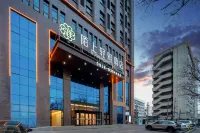


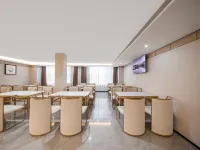


85
Hotel near Tianshui City Square,Tianshui
 No. 1 of 4-Star Select Hotels in Tianshui
No. 1 of 4-Star Select Hotels in TianshuiHiking
Gym
Public parking
+13
"Upon arrival, the front desk proactively upgraded my room. I had also mistakenly booked a queen room for my other reservation, and the front desk staff kindly changed it to a twin room and even upgraded that one as well, plus they sent up some fruit. Everyone greeted me warmly when I entered and left the lobby, which was very welcoming. My high-speed train was at 6 PM, and I wanted two extra hours of rest, so I requested a late check-out and offered to pay, but they actually let me check out for free until 4 PM. Overall, I felt very comfortable and at ease. It's a great choice for travelers, highly recommended!"
Outstanding
2577 reviews
9.4/10
1 night
From PHP 1,511
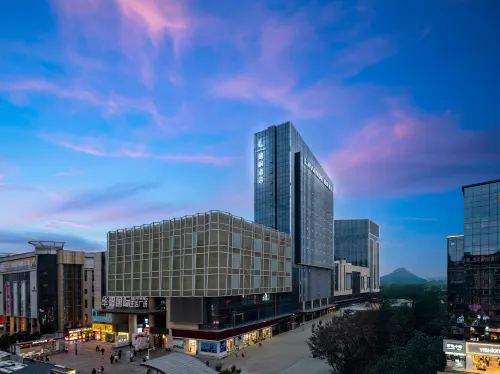



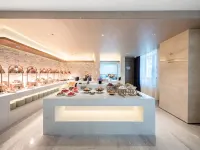
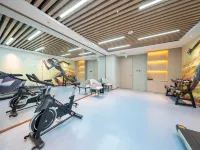

99+
Hotel near Tianshui Railway Station,Tianshui
Gym
Public parking
Luggage storage
+9
"The location of the hotel is excellent, the travel is very convenient, there are various gourmet shops and shopping malls nearby, one-stop solution for eating, drinking and playing. At the time of check-in, the front desk staff was enthusiastic and professional. Not only did the procedures be completed soon, but also intimately recommended me a fun place in the local area.
The room was clean and tidy, the bedding was soft and comfortable, and it was like being wrapped in clouds. I slept very well all night. The breakfast is rich in variety, both Chinese and Western, and the hot freshly ground coffee is matched with the freshly baked bread, opening a full day.
This experience is impeccable, next time you come here, you will definitely choose this one!"
Very Good
722 reviews
9.3/10
1 night
From PHP 1,494







99+
Hotel near Tianshui City Square,Tianshui
 No. 13 of 4-Star Select Hotels in Tianshui
No. 13 of 4-Star Select Hotels in TianshuiPublic parking
EV charging station
Luggage storage
+10
"I always like staying here. It's clean, comfortable, and the location is perfect. It's on all the major bus lines, walking distance to the best parts of Tianshui and quiet. The staff is always friendly and professional and the breakfast is really good."
Good
1269 reviews
9.0/10
1 night
From PHP 2,153
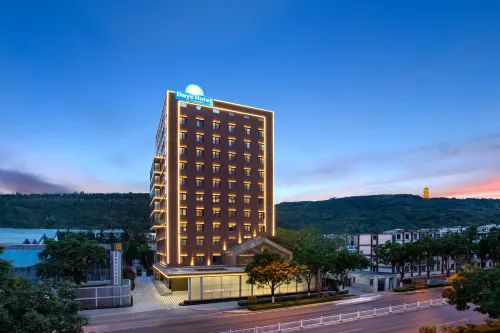



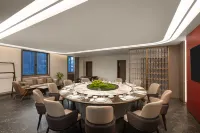

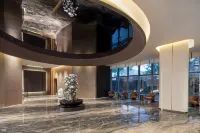
71
Hotel near Wanda Plaza(Qinzhou),Tianshui
 No. 4 of 4-Star Select Hotels in Tianshui
No. 4 of 4-Star Select Hotels in TianshuiPrivate parking
Luggage storage
Restaurant
+2
"I was really touched by the service details at the front desk, and I came to Tianshui for a business trip. The front desk intimately reserved my favorite room type in advance. The service was in place. The Nanguo Temple was next door. You can go for a walk after dinner at night. I really like it. The young lady at the front desk is really gentle. The nearby Wanda business district is also very convenient. I will come next time. I can give your friends a reference."
Very Good
494 reviews
9.3/10
1 night
From PHP 2,752





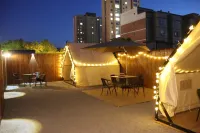

61
Hotel near Tianshui Railway Station,Tianshui
Public parking
Private parking
EV charging station
+4
"Ok in the listing it was not indicated that the bathroom is shared (many guesthouses put this info in the title of the room categories. But probably one could have guessed by way this guesthouse was only displaying only 2 room photos without any bathroom photo. But the price is cheap, very close to the railway station, fast wifi, bottled water and friendly service. The shared bathroom is a bit of a walk from the room in open air setting. Probably difficult in winter. But the weather in Tianshui in June was warm so that’s good. Checkin process also took a while for foreigner’s registration. Overall, it was an okay for budget stay for 1 night before taking the train."
Excellent
42 reviews
9.6/10
1 night
From PHP 397
Trip.com's insights for hotels in Tianshui
Plan smarter with Trip.com’s data-backed insights on travel seasons so that you can book your Tianshui hotel at the right time!
Which month offers the lowest hotel rates in Tianshui?
November is the most affordable month to book a hotel in Tianshui, with average nightly rates around PHP 2,516. Prices peak in August, when rates reach about PHP 4,837 per night.
(Based on Trip.com data from January 3, 2025 to January 3, 2026.)
(Based on Trip.com data from January 3, 2025 to January 3, 2026.)
0
PHP 2,000
PHP 4,000
PHP 6,000
PHP 3,343
Jan
PHP 2,685
Feb
PHP 3,293
Mar
PHP 4,272
Apr
PHP 3,968
May
PHP 2,904
Jun
PHP 3,428
Jul
PHP 4,837
Aug
PHP 3,056
Sep
PHP 3,537
Oct
PHP 2,516
Nov
PHP 2,575
Dec
What is the cheapest day of the week for hotels in Tianshui?
Hotel rates in Tianshui are typically lowest on Friday, with average nightly rates around PHP 2,997. Saturday tends to be the most expensive, averaging PHP 4,179 per night.
(Based on Trip.com data from January 3, 2025 to January 3, 2026.)
(Based on Trip.com data from January 3, 2025 to January 3, 2026.)
0
PHP 2,000
PHP 4,000
PHP 6,000
PHP 3,436
Mon
PHP 3,444
Tue
PHP 3,014
Wed
PHP 3,250
Thu
PHP 2,997
Fri
PHP 4,179
Sat
PHP 3,090
Sun
Among Trip.com users, which area in Tianshui is most popular for hotel bookings?
Tianshui City Square is the most popular area in Tianshui for hotel searches on Trip.com, with an average price of PHP 5,732. Moshang Qingya Hotel (Tianshui Ancient City Lantian City Square Branch), Xinglinchun Hotel, and Baiyu Eiffel Hotel (Tianshui City Government Central Plaza) are among the top-rated hotels in Tianshui City Square.
(Based on Trip.com data from January 3, 2025 to January 3, 2026.)
(Based on Trip.com data from January 3, 2025 to January 3, 2026.)
0
PHP 2,000
PHP 4,000
PHP 6,000
Wanda Plaza(Qinzhou)
PHP 5,732
Wanda Plaza(Qinzhou)
Tianshui City Square
PHP 3,543
Tianshui City Square
Tianshui Railway Station
PHP 2,773
Tianshui Railway Station
Maiji Mountain Scenic Area
PHP 1,847
Maiji Mountain Scenic Area
Trending places in Tianshui
Find top attractions and hotspots in Tianshui
Landmarks
Fuxi Temple
53 hotels
Tianshui Ancient City
53 hotels
Immortal Cliff
29 hotels
Yuquanguan Scenic Area
55 hotels
Tianshui Railway Station
38 hotels
Nanguo Temple
90 hotels
Popular areas
Tianshui City Square
42 hotels
Tianshui Railway Station
40 hotels
Wanda Plaza(Qinzhou)
10 hotels
Maiji Mountain Scenic Area
11 hotels
Find your unique stays in Tianshui
Immerse yourself in the vibrant atmosphere of Tianshui with our handpicked accommodation options
Top hotel picks in Tianshui
See all
Check out these top-booked hotels from the past 30 days!
No.1
9.3/10
366 reviewLinglan Hotel (Tianshui Railway Station Second People's Hospital Branch)
Hotel near Tianshui Railway Station, Tianshui 33.1% of visitors choose this area
"Convenient parking""Classy environment"
Select dates to view pricesNo.2
9.2/10
1285 reviewXinglinchun Hotel
Hotel near Tianshui City Square, Tianshui 56.3% of visitors choose this area
"Great amenities""Classy environment"
Select dates to view pricesNo.3
9.5/10
3298 reviewBaiyu Eiffel Hotel (Tianshui City Government Central Plaza)
Hotel near Tianshui City Square, Tianshui 56.3% of visitors choose this area
"Friendly front desk staff""Easy to get around"
Select dates to view pricesNo.4
9.2/10
827 reviewSilu Wanli Hotel
Hotel near Tianshui Railway Station, Tianshui 33.1% of visitors choose this area
"Friendly front desk staff""Delicious breakfast"
Select dates to view pricesNo.5
9.4/10
185 reviewTianshui ancient city Hi-hidden guesthouse
Hotel near Tianshui City Square, Tianshui 56.3% of visitors choose this area
"Classy environment""Great design"
Select dates to view pricesNo.6
8.9/10
3162 reviewCrystal Garden Hotel (Tianshui Ancient City Fuxi Temple)
Hotel near Tianshui City Square, Tianshui 56.3% of visitors choose this area
"Great amenities""Friendly front desk staff"
Select dates to view pricesNo.7
8.3/10
546 reviewCentury Golden Flower Light Hotel (Tianshui Central Plaza)
Hotel near Tianshui City Square, Tianshui 56.3% of visitors choose this area
"Classy environment""Easy to get around"
Select dates to view pricesNo.8
9.3/10
1353 reviewWassim Hotel (Tianshui guccheng Fuxi Temple)
Hotel near Tianshui City Square, Tianshui 56.3% of visitors choose this area
"Friendly front desk staff""Convenient parking"
Select dates to view pricesNo.9
9.0/10
284 reviewHualong International Holiday Hotel
Hotel near Tianshui Railway Station, Tianshui 33.1% of visitors choose this area
"Great amenities""Classy environment"
Select dates to view pricesNo.10
8.4/10
487 reviewFanhua Xili Hotel (Tianshui Fuxi Temple Ancient City Branch)
Hotel near Tianshui City Square, Tianshui 56.3% of visitors choose this area
"Convenient location""Friendly front desk staff"
Select dates to view pricesHotels with tasty breakfast in Tianshui
See all
Start your day with a tasty breakfast at one of our favourite hotels in Tianshui.
Jia Fu Hotel
Hotel near Tianshui City Square, Tianshui 56.3% of visitors choose this area
The Jia Fu Hotel provides a great place for travelers to relax after a busy day. The Jia Fu Hotel is an ideal choice for travelers who want to take in the sights and sounds of Tianshui. The hotel offers easy access to Nanhechuan Railway Station, just 13km away. The nearby area boasts an abundance of attractions including Tianshui Museum, Fuxi Temple and Tianshui Ancient City. After a long day of sightseeing, guests can retire to the comfort of the hotel. Guests of this Tianshui hotel can make use of the parking facilities. According to our guests, this hotel provides a very high level of service. This hotel is a popular accommodation for guests traveling with families.
9.0/10
Good789 reviewPrice per night from:PHP 2,381
Public Air Travel Maijishan Pearl Hotel
Hotel near Maiji District, Tianshui
The room was spacious and clean, with all the necessary hardware and software. The restaurant's Chinese cuisine was excellent, with a strong Longdi flavor. The Maiji Mountain Visitor Center is a few minutes away, but you still need to take the scenic bus to reach the Maiji Mountain Scenic Area.
9.3/10
Very Good1552 reviewPrice per night from:PHP 1,731
GanguJintian.YuhuaHotel
Hotel near Gangu
The feeling of staying this time is very good. When I came to Gangu County on a business trip, I found that the hotel had not opened yet. This time I came on a business trip and found that the hotel had opened. I chose to stay without hesitation.
All the hotel facilities are the top in Gangu County, and this hotel should be the most luxurious hotel in the local area.
The room has a very large floor-to-ceiling window, and the experience of staying in is very good. At noon, the sun outside came in and fell on the ground, drinking tea and enjoying the sunbathing, which was very comfortable.
There are many hotel room types and there are many choices available. The overall decoration of the room is warm in color, giving people a very comfortable feeling. Although it is a newly opened hotel, the room has no smell, so you can stay at ease.
The overall hygiene of the hotel room is very clean, the space is very large, the bathtub is equipped, the quilt is a duvet, this is a very good plus for the hotel. The hotel's bedding is a brand mattress, which has a very good support effect on the waist, and it is very comfortable to fall asleep. The pillow provides two choices, one is down, and the other is a soft pillow with buckwheat skin. This is a bit lowering the grade of the hotel. Now many hotels are equipped with latex and down pillows, because many people, including me, are not very good at cervical spine. If the soft pillow is a soft pillow, the cervical spine pressure is relatively large. If the latex pillow is a bad pillow, it is better for people with bad cervical spine.
The soft drink area is a common hotel configuration, there are two packs of tea, two packs of coffee, the refrigerator below is empty, you can consider adding some soft drinks without cost, or charging separately.
The toilet belongs to the Zhitong toilet, and has a toilet heating function. The disadvantage is that you can consider adding a disposable toilet pad in the future, which will bring a better accommodation experience. The room has a bathtub, and I hope it can also be equipped with a bathtub cover to increase the accommodation experience.
The washing area is also remarkable. I have stayed in many hotels. The new hotel is almost not equipped with a makeup mirror. Although the cost is not high, whether it is a woman's makeup or a man's shave, this makeup mirror can provide very big help. The hotel is equipped with a makeup mirror. This one immediately brought the grade up.
Finally, I hope to advance the professionalism of all service personnel.
Special thanks to Manager Li Xiaoxia and Li Hua at the front desk. The two of them are very attentive and I am grateful.
/10
Price per night from:PHP 1,680
MEHOOD LESTIE Hotel (Tianshui South Station Shengda Plaza)
Hotel near Tianshui Railway Station, Tianshui 33.1% of visitors choose this area
Meihao Lizhi Hotel Tianshui Nanzhan Shengda Plaza Store is located in Maqi District, Tianshui City, where Meihao Hotel Technology and Gansu Zhongsen Industrial and Trade Co., Ltd. have teamed up to jointly build Tianshui's first Meihao Lizhi Hotel - a city resort hotel. It is meticulously crafted and carefully cultivated with high-quality facilities and a minimalist and elegant style, creating an ideal choice for middle to high-end business travelers. The hotel covers an area of more than 10,000 square meters, with a total of ten floors, including a basement and nine above-ground floors. The ground floor is the hotel lobby, the second and third floors are the catering area, with 20 modern style private dining rooms. The breakfast restaurant is on the second floor. The fifth to ninth floors are the guest room area, with 101 smart guest rooms designed by international top teams, with a business-simple style. All guest rooms use five-star hotel bedding and personalized brand bathroom supplies. The laundry room and gym are on the east side of the eighth floor. The tenth floor is the hotel's 650 square meter multi-function banquet hall, which can accommodate 360 people for meals at the same time. Meihao Lizhi Hotel - a hotel you want to stay in even when you don't have to leave home.
9.4/10
Outstanding1746 reviewPrice per night from:PHP 2,406
Jin Cheng Hotel
Hotel near Gangu
Gangu Jincheng Hotel is located in Tianshui City, Gangu County, South Riverside Road, from the national 4A-class scenic area - Dapangshan Grottoes about a few minutes drive, convenient travel.The hotel is built by Gansu Takahashi Construction Group Co., Ltd., with warm and comfortable rooms, elegant dining environment, advanced and complete facilities and quality services to attract people from all walks of life, is engaged in business negotiations, tourism activities of the best choice
9.6/10
Excellent363 reviewPrice per night from:PHP 1,317
Binhe Grand Hotel (Tianshui High-Speed Railway South Station)
Hotel near Tianshui Railway Station, Tianshui 33.1% of visitors choose this area
The Binhe Grand Hotel (Tianshui High-Speed Railway South Station) is an ideal spot for travelers wanting to discover the city. The Binhe Grand Hotel (Tianshui High-Speed Railway South Station) is an ideal choice for travelers who want to take in the sights and sounds of Tianshui. The hotel is just 1km away from Tianshui Railway Station. The nearby area boasts an abundance of attractions including ShangBu Lu BuXingJie, TianShui WenHua LvYou ShangYeJie and Green Bull Garden. This hotel makes a great place to kick back and relax after a long day of sightseeing. For those driving themselves, parking is provided on site. If you demand a high level of service, our guests have indicated that this hotel has excellent standards. This hotel is particularly popular with those traveling with families.
9.2/10
Very Good1233 reviewPrice per night from:PHP 1,545
Xinhai International Hotel (Tianshui South Station Shengda Plaza Branch)
Hotel near Tianshui Railway Station, Tianshui 33.1% of visitors choose this area
Easy parking, convenient vehicle access, easy parking spaces.
The hotel fragrance is very good, the comfort is high, the hotel room is large, clean, the water temperature is comfortable, the bath can be, there is no problem of water pressure not enough water.
The best thing is that the table has a lamp, which is especially convenient! !
There are many hot and cold dishes for breakfast, many types, fruits, porridge, etc., and the staff cooks rice noodles separately. The staff is very good.
It is recommended to strengthen sound insulation. I don't know why the dining in the courtyard was very noisy that night, and the corridor was not soundproof.
The overall feeling is very good, you can stay next time.
I forgot to take the picture and found the official picture to put it up. This time the room type I lived in was this.
9.3/10
Very Good71 reviewPrice per night from:PHP 1,756
Shan Shui Garden Hotel
Hotel near Tianshui Railway Station, Tianshui 33.1% of visitors choose this area
The Shan Shui Garden Hotel (Shanshuiyuan Jiudian) is only locacated close to the the Tianshui downtown area. The hotel is about a 10-minute drive to the Tianshui Railway Station and the Tianshui Airport.The hotel features taxi and ticket booking sercices and Wi-Fi in public areas.The on-site Chinese restaurant serves Huaiyang, Sichuan, Cantonese and local cuinine. Additionally, guests can also dine at the Western restaurant. Guests also have the option to visit the lovvy bar or coffee shop.Business users can take advantage of the business center or utilizt the various meeting rooms.. At the end of the day guests can work-out at the gym or visit the games room.
9.1/10
Good617 reviewPrice per night from:PHP 1,655
Tianshui Maiji Mountain Hot Spring Tourism Hotel
Hotel near Maiji District, Tianshui
The Tianshui Maiji Mountain Hot Spring Tourism Hotel is an ideal spot for travelers wanting to discover the city. The Tianshui Maiji Mountain Hot Spring Tourism Hotel offers a pleasant stay in Tianshui for those traveling for business or leisure. From the hotel, Tianshui Railway Station is approximately 23km away. Tianshui Railway Station is the closest option for those who prefer to travel by train, approximately 23km away. The nearby area boasts an abundance of attractions including Maijishan Hot Spring, Wenjiaxia and Hot Spring Bath House. At the end of a busy day, travelers can unwind and relax in the hotel or go out and enjoy the city. For those driving themselves, parking is provided on site. Our guests consider this hotel to have excellent service. This hotel is a popular accommodation for guests traveling with families.
9.1/10
Good1098 reviewPrice per night from:PHP 2,786
Tianshui Dizhi Hotel
Hotel near Tianshui Railway Station, Tianshui 33.1% of visitors choose this area
The Tianshui Dizhi Hotel is an ideal spot for travelers wanting to discover the city. The Tianshui Dizhi Hotel offers a pleasant stay in Tianshui for those traveling for business or leisure. The hotel offers easy access to Tianshui Railway Station, just 3km away. With multiple attractions nearby including Mapaoquan Water Park, Tianshui Great Revolution History Museum and Tianshui Dragon Garden, guests will find plenty to keep themselves occupied. In their spare time, guests can explore the hotel's surroundings. This Tianshui hotel offers parking on site. When it comes to Tianshui hotels, the Tianshui Dizhi Hotel is highly regarded for its excellent facilities. This hotel is a popular accommodation for guests traveling with families.
9.5/10
Outstanding492 reviewPrice per night from:PHP 2,178
Latest Reviews for Tianshui hotels
See all
Explore genuine reviews and ratings from real travellers to find the perfect accommodation for your needs.
9.7/10
Excellent
MM9249****It can be seen that the young couple is running the business very carefully. The location of the B&B is good. We arrived at around five o'clock in the afternoon, and there were not many people in the grotto. The tour guide provided by the boss was very good, explained in detail, told us where to take good photos, and helped us take group photos at several points. I strongly recommend everyone to come in the evening and use the tour guide provided by the boss. Great experience. The food is rich in mountain flavor. Specialties, Tianshui Guagua Ranran Laolao. It tastes very good. Breakfast is also provided for 15 people, which is enough. All in all, I highly recommend him.
Homestays in the distance of Maiji Mountain
Hotel near Maiji Mountain Scenic Area, Tianshui 6.7% of visitors choose this area
Price per night from:PHP 1,190
9.5/10
Outstanding
PPeterThis is a REALLY nice hotel. Unfortunately, although it is practically right next to one of the city's two train stations, the location is far from ideal. Yes, there are many restaurants close by. But Tianshui is an oddly laid out city. Look on a map and you will see two distinct parts to the city. This hotel, along with the two train stations and the airport are in the eastern city. But all the most interesting city attractions are within the west part. And the two parts are very far from each other.
Again, this is a nice, quiet, comfortable hotel. And I often try to stay at hotels near transportation centers such as train stations. The view from my room was fabulous- mountains and a train station.
But for anyone visiting Tianshui, I'd suggest you look closely at a map and take a close look at the sites within the city you are likely to visit! (To add to within-town transportation challenges, not even a single time was I able to get a ride using the normally useful ”Didi” application. This meant that it was a constant ”old school” process of trying to flag down available taxis.
Anyway, again I will emphasize, the hotel is great. It is the layout of the city itself that presents challenges that make this location difficult.
Xana Hotelle· Tianshui Railway station pedestrian street shop
Hotel near Tianshui Railway Station, Tianshui 33.1% of visitors choose this area
Price per night from:PHP 1,190
9.5/10
Outstanding
GGuest UserThe King Room with Window at Hanting Hotel that I stayed in this time exceeded my expectations overall! The room is of moderate size, with a simple and warm layout, and the design of original wood tones makes people feel relaxed. The big bed is moderately soft and hard, the bedding is clean and comfortable, and I can sleep without any pressure until dawn. What I am most satisfied with is the windows in the room, which provide ample lighting and good ventilation. The sunlight coming in in the morning is particularly soothing, and at night I can see the street lights, without feeling oppressive at all.
The hygiene details are in place, there are no obvious stains on the floor, table and toilet, the air conditioner cools quickly and quietly, the shower water pressure is stable, and there is plenty of hot water. The staff is friendly, the front desk is efficient, and the response to needs is timely. The hotel is conveniently located with restaurants and convenience stores nearby.
HanTing Hotel (Tianshui Central Square)
Hotel near Tianshui City Square, Tianshui 56.3% of visitors choose this area
Price per night from:PHP 1,739
9.1/10
Good
CChezzaThis new hotel was a wonderful place to stay. The new facilities were clean and tidy. The bedroom was temperature controlled, which was great in the cold winter. I especially liked the little table area to relax next to the bed. In the lobby, there were also free password locked luggage storage units that are convenient if you need somewhere to store your luggage for a few hours after check out. As well as that, I was surprised to find the washing machine and dryer in the lobby were also free for use. I communicated with staff in Chinese (I didn't even try to use English) and they were always happy to help. I think I would have, however, appreciated a little more information on check in as I only realized as I was leaving that I hadn't taken advantage of the free breakfast...and didn't know how to access it.
Hi Inn (Tianshui South Railway Station Qiaonan Building Materials City)
Hotel near Tianshui Railway Station, Tianshui 33.1% of visitors choose this area
Price per night from:PHP 1,216
9.1/10
Good
WWoaidalvxingThe hotel is in a good location, not far from the train station and in a busy area! The room is not big, it is quite standard, compact and small! The hygiene and bedding comfort are average, nothing to praise! I would like to mainly comment on the hotel's facilities and service attitude. First, the bathroom is small and inconvenient for taking a shower. The air conditioning starts slowly and can't heat up for a while. The room is too cold and I dare not take off my clothes. This needs improvement. Secondly, the room network is out of order. I couldn't connect to the wireless network. I asked the hotel engineer to come over and say that the network cable was broken and needed to be repaired by professionals from the telecommunications company. The next day, the professionals checked and said that the set-top box had been replaced and needed to be reconfigured. It took two days for the repair to be completed. There was no internet or TV, which was very frustrating. I had to change to another hotel. The second thing was that the hotel did not accept objective and true reviews, and used long speeches to refute my reviews. I don't think it was necessary. Since they don't accept bad reviews, The key is to improve the service! It's really not worth it to say that I threatened them with bad reviews. Since I have made such a confident rebuttal, why should I delete and change it? Instead of going to so much trouble to discredit my review, it is better to be realistic and implement the service at the hotel front desk. It is really better than saying anything. I hope we can encourage each other!
CHEERMAY Hotel (Tianshui Baicheng Railway Station Shangbu Road Pedestrian Street)
Hotel near Tianshui Railway Station, Tianshui 33.1% of visitors choose this area
Price per night from:PHP 971
9.0/10
Good
AAnonymous UserRead lots of reviews about this hotel before booking it for a night. I'll still give it a 5-star review because it is so convenient for independent travellers like us. The railway station as well as the local public buses station/stops are just a few minutes walk away from the hotel. The rooms are clean and spacious, the bathroom shower has strong flow of water. It's near to the famous Malatang eateries, too, just less than 5 minutes walk away.
The rooms are not sound proof and we can hear the next door guests talking. Since it was already 12.30 midnight, we couldn't get to sleep due to the non-stop talking in the next room, we decided to seek help from the counter staff to give us a quiet room. She was so kind and moved us to another room on the same floor in the middle of the night. Kudos to this kind lady.
Tianshui Jinsha Hotel (Tianshui Station Commercial Street Pedestrian Street Branch)
Hotel near Tianshui Railway Station, Tianshui 33.1% of visitors choose this area
Price per night from:PHP 1,562
8.9/10
MM858809****The room is very spacious, the air conditioning temperature is well controlled, and the bedding is clean and fresh. In the evening, I came for room service. Miss Wanzi at the front desk specially helped me adjust the direction of the room. She also introduced the surrounding attractions and food in detail. The shower gel smelled great. Stayed here for two days. The room was quite big and tidy. Check-in and check-out were quick. The bedding was of good quality and I slept very comfortably. It was very quiet downstairs at night and there were several towels, which was very considerate. The facilities in the room are all new. Nothing bad.
JunZhi Collection Hotel(Tianshui First Peopies HOSPITAL longcheng Square Store)
Hotel near Tianshui City Square, Tianshui 56.3% of visitors choose this area
Price per night from:PHP 1,114
8.6/10
EErbaobaAdvantages: 1. Close to the scenic spot, less than 2 kilometers; 2. The room bedding is clean and hygienic; 3. No mosquitoes (I don't know if it is geographical or climate). 4. Convenient parking. 5. Service is not bad. 6. Meals can be booked separately (did not eat, do not know how the dishes taste).
Disadvantages: 1. The road to the scenic spot is a one-way street. You have to come back from the other side of the river. At present, the road is being built on the other side. You can take a shortcut and drive back from the temporary road on the river. Take a taxi or take a bus to the gate of the scenic spot, and there is this choice. Because the parking lot to drive to the scenic spot is not open to private cars. 2. There is no bathroom in the triple room, and the toilet and shower can be used (the two have a bathroom, whether there is rain is not sure). 3. There is no air conditioning, but even around August 10, the night is very cool, the toilet has 17 degrees, and the quilt has to be covered. The sign hanging in the hotel is the sculpture museum, and I thought I was in the wrong place at first.
Tianshui Maiji District District Artists‘ home
Hotel near Maiji Mountain Scenic Area, Tianshui 6.7% of visitors choose this area
Price per night from:PHP 1,047
8.3/10
EE0903****The hotel is located opposite Tianshui Railway Station and can be reached in three minutes on foot. There are many restaurants around and it is very convenient to eat. There are buses to various scenic spots in the railway station square, such as going to Maijishan Grottoes. You have to take the 34 bus to the terminal station, which is the entrance of the scenic spot. The rooms are large in size, very clean, the lobby is also very stylish, the front desk girl is warm and impressed. Friends who recommend going to Tianshui can rest assured to choose this hotel!
Tianshui Yueju Boutique Hotel (Tianshui Station)
Hotel near Tianshui Railway Station, Tianshui 33.1% of visitors choose this area
Price per night from:PHP 675
8.1/10
CChezzaThis hotel was perfect for my needs. I was looking for a clean and convenient budget hotel not far from the long distance bus station and town centre. The staff were friendly and helpful, although as expected they didn't speak English (which is what I expected). I slept soundly, enjoyed the hot shower and had a good stay in Zhangjiachuan partly thanks to this hotel. Overall, it is typical of the older type of budget hotel I have stayed at in China.
FAQs About Hotels in Tianshui
What are the most popular hotels in Tianshui?
There are many popular options for hotels in Tianshui. Whether you're traveling for business or a vacation, Moshang Qingya Hotel (Tianshui Ancient City Lantian City Square Branch) (from PHP 833), Linglan Hotel (Tianshui Railway Station Second People's Hospital Branch) (from PHP 572) and Xinglinchun Hotel (from PHP 825) are popular choices.
What is the average price for hotels in Tianshui?
The average price for hotels in Tianshui is PHP 1,775 for weekdays, and PHP 1,787 for weekends (Friday–Saturday).
What are the best hotels for families in Tianshui?
Moshang Qingya Hotel (Tianshui Ancient City Lantian City Square Branch) (from PHP 833), Baiyu Eiffel Hotel (Tianshui City Government Central Plaza) (from PHP 1,086) and Silu Wanli Hotel (from PHP 1,338) are popular hotels for family travel. Book now from Trip.com and enjoy your time with families!
What are popular hotels with high-quality breakfasts in Tianshui?
Jia Fu Hotel (from PHP 2,374),Public Air Travel Maijishan Pearl Hotel (from PHP 1,254) and GanguJintian.YuhuaHotel (from PHP 1,162) are popular hotels with high-quality breakfast. Start your wonderful journey with tasty breakfast!
What are available deals for hotels in Tianshui?
There are multiple promotions and discounts all year round for Trip.com users . Please check the promotions page to see what promotions are available now on Trip.com.
Which hotels with fitness facilities in Tianshui are popular?
Moshang Qingya Hotel (Tianshui Ancient City Lantian City Square Branch) (from PHP 833), Baiyu Eiffel Hotel (Tianshui City Government Central Plaza) (from PHP 1,086) and Atour Hotel (Tianshui South High-speed Railway Station Shengda Plaza) (from PHP 833) are popular hotels with a fitness center. Keep your fitness plan during traveling from Trip.com!
Which pet-friendly hotels in Tianshui are recommended?
Fanhua Xili Hotel (Tianshui Fuxi Temple Ancient City Branch) (from PHP 1,263), Homestays in the distance of Maiji Mountain (from PHP 673) and James Joyce Coffetel Hotel (Tianshui South Station Qiaonan International Shopping Center) (from PHP 833) are popular pet-friendly hotels. Take your pets with you during traveling.
Which popular hotels in Tianshui offer free Wi-Fi ?
Whether you're traveling on business or for vacation, internet connection is an essential facility. Moshang Qingya Hotel (Tianshui Ancient City Lantian City Square Branch) (from PHP 833), Linglan Hotel (Tianshui Railway Station Second People's Hospital Branch) (from PHP 572) and Xinglinchun Hotel (from PHP 825) are popular hotels with free Wi-Fi.
Which hotels in Tianshui have swimming pools?
Xinglinchun Hotel (from PHP 825), Hexieyuan Hotel (from PHP 4,058) and Tangyu Hot Spring Resort (from PHP 1,094) provide awesome swimming pools. Book now and enjoy your swimming pool!
Which hotels in Tianshui are good for couples?
When traveling to Tianshui, it is popular for couples to stay at Hexieyuan Hotel (from PHP 4,058).
What are the best sap hotels in Tianshui?
A spa treatment can be the perfect way to unwind after a long day of travel. Tianshui Maiji Mountain Hot Spring Tourism Hotel (from PHP 2,846) provides wonderful spa services.
Which hot spring hotels in Tianshui are recommended?
Consider hot springs in your hotel during traveling? Tianshui Maiji Mountain Hot Spring Tourism Hotel (from PHP 2,846) has wonderful hot springs. Book now!
What are best luxury hotels in Tianshui?
Tianshui has many wonderful luxury hotels with good service. Public Air Travel Maijishan Pearl Hotel (from PHP 1,254), Jia Fu Hotel (from PHP 2,374) and GanguJintian.YuhuaHotel (from PHP 1,162) are popular options.
Tianshui Hotels Information
Number of Reviews
130,333
Total Properties
131
Weekday Avg. Price
PHP 1,775
Weekend Avg. Price
PHP 1,787
Trending hotel
Moshang Qingya Hotel (Tianshui Ancient City Lantian City Square Branch)
Popular area
Tianshui City Square
Keep Exploring
Popular hotels in Tianshui
James Joyce Coffetel Hotel (Tianshui South Station Qiaonan International Shopping Center)Jia Fu HotelPublic Air Travel Maijishan Pearl HotelLangting Business Hotel (Tianshui Ancient City Fuxi Temple)Maijishan Warm FarmhouseTianshui ancient city Hi-hidden guesthouseBaiyu Eiffel Hotel (Tianshui City Government Central Plaza)Hualong International Holiday HotelTianshui Yueju Boutique Hotel (Tianshui Station)Lvyinge Farm StayVienna Hotel 5.0 Tianshui South Station Sheng Da Plaza BranchHexieyuan HotelWassim Hotel (Tianshui guccheng Fuxi Temple)Elong R.YUN Hotel (Tianshui Railway Station Shangbu Road Pedestrian Street)Hi Inn (Tianshui Municipal Government Central Plaza)
Tianshui Hotels near Attractions
Hotels near Tianshui Maiji Mountain scenic areaHotels near NanzhaiziHotels near Maijishan Cave-Temple ComplexHotels near Yuquanguan Scenic AreaHotels near Tianshui Ancient CityHotels near Tianshui MuseumHotels near Tianshui Normal UniversityHotels near Fuxi TempleHotels near Nanguo TempleHotels near Li Guang TombHotels near Tianshui Maijishan AirportHotels near Tianshui Railway Station
Flights from Popular Cities to Tianshui
Toronto to Vancouver FlightsCalgary to Vancouver FlightsEdmonton to Vancouver FlightsVancouver to Calgary FlightsToronto to Calgary FlightsVancouver to Edmonton FlightsVancouver to Toronto FlightsToronto to Edmonton FlightsEdmonton to Toronto FlightsKelowna to Vancouver FlightsVancouver to Kelowna FlightsToronto to New York FlightsCalgary to Toronto FlightsVancouver to Hong Kong FlightsVancouver to Tokyo Flights

